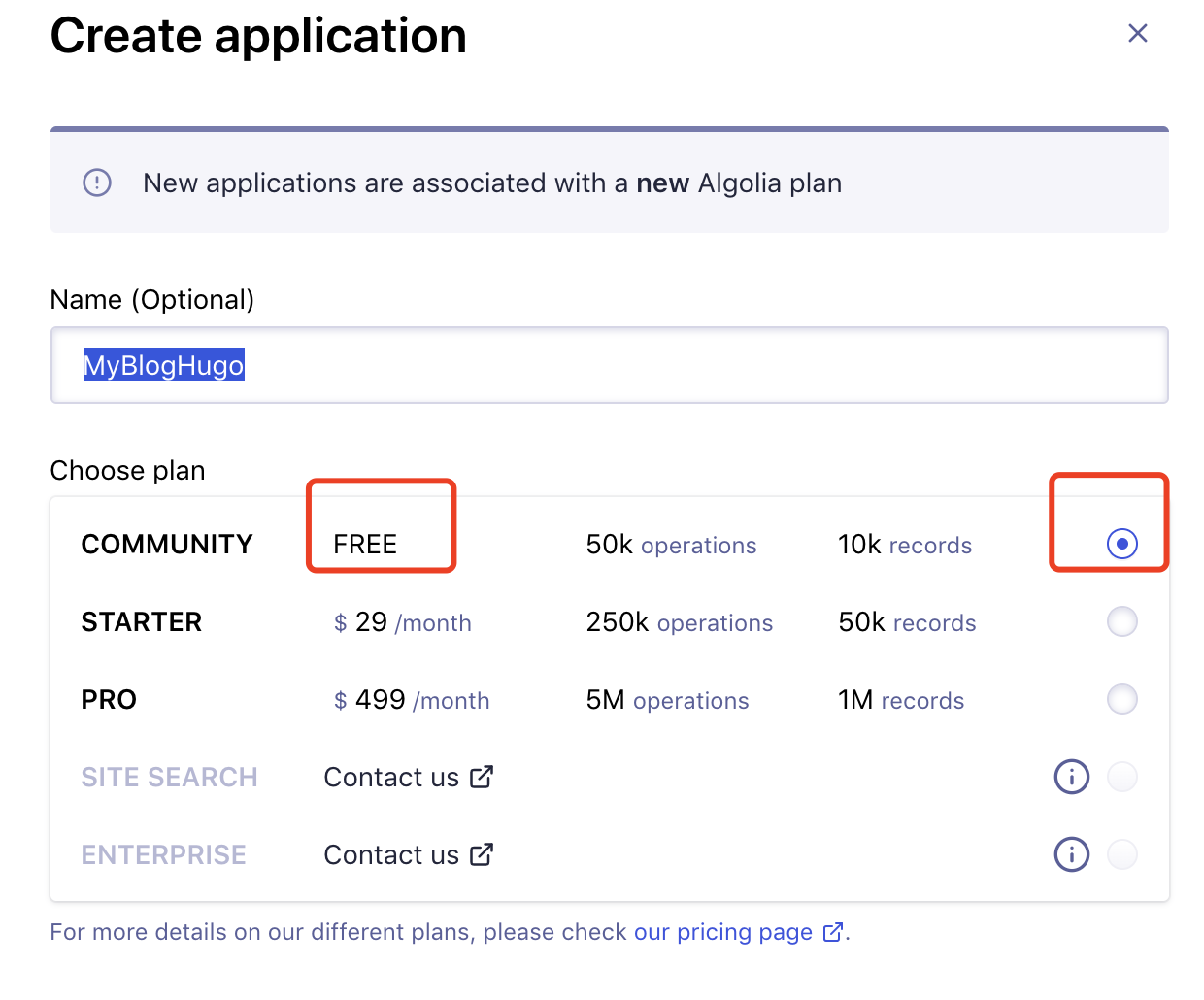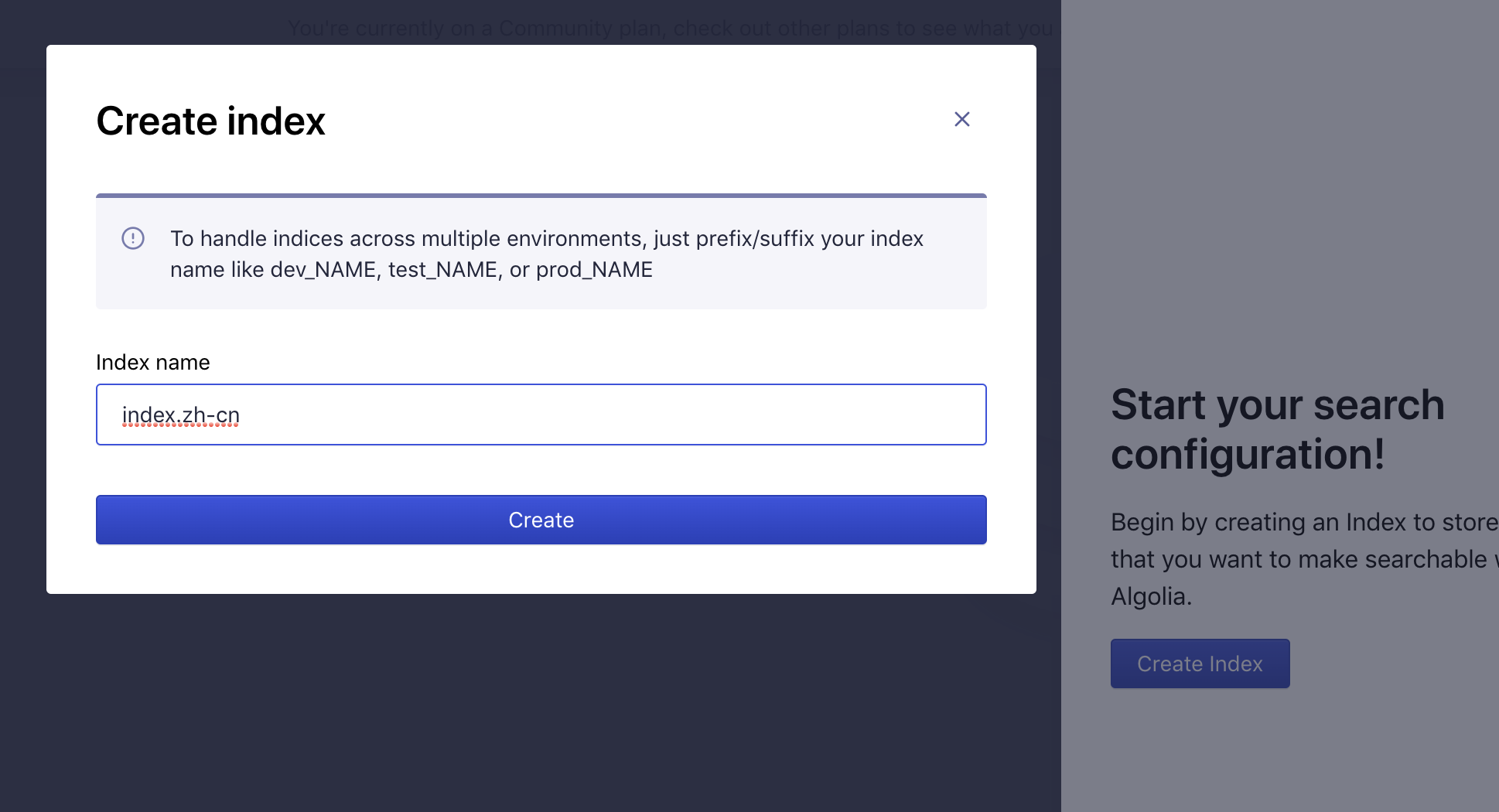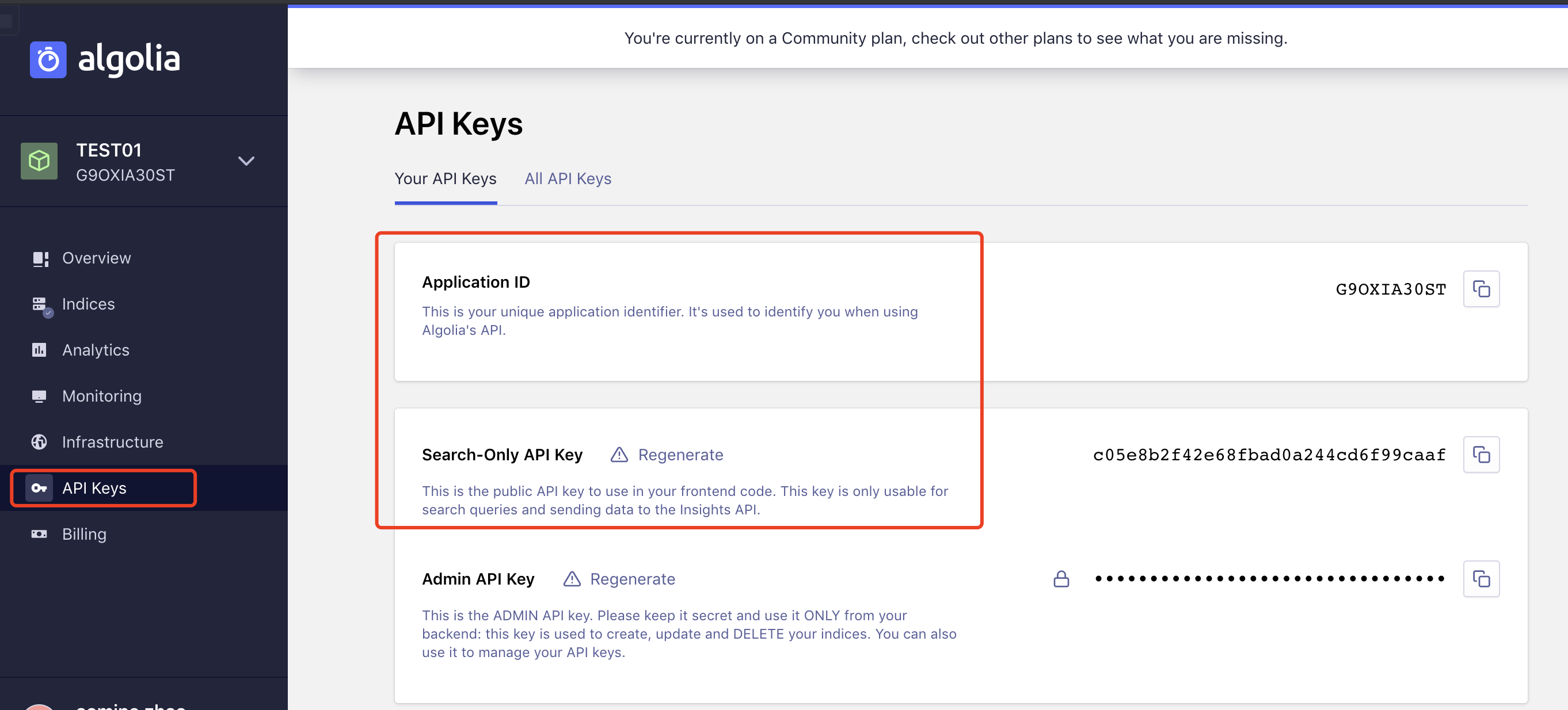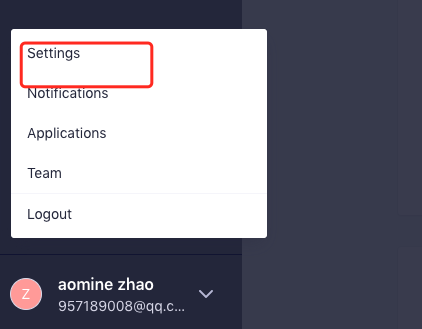警告
本文最后更新于 2021-12-26,文中内容可能已过时。
使用一些简单的 shell 脚本处理自己的 hugo 博客和搜索
1 config.toml 配置
1.1 首先我们配置好 config.toml 的 algolia 的配置
1
2
3
4
5
6
7
8
9
10
11
12
13
14
15
16
17
18
19
20
21
|
# 搜索配置
[languages.zh-cn.params.search]
enable = true
# 搜索引擎的类型 ("lunr", "algolia")
type = "algolia"
# 文章内容最长索引长度
contentLength = 4000
# 搜索框的占位提示语
placeholder = "搜索"
# 最大结果数目
maxResultLength = 10
# 结果内容片段长度
snippetLength = 50
# 搜索结果中高亮部分的 HTML 标签
highlightTag = "em"
# 是否在搜索索引中使用基于 baseURL 的绝对路径
absoluteURL = true
[languages.zh-cn.params.search.algolia]
index = "index.zh-cn" #algolia 里面的 index 名称相对应,如果你有多语言版本,那么就需要创建多个语言的 index,我这里仅举例中文的版本
appID = ""
searchKey = ""
|
2 Algolia 配置

2.2 我这里选择香港作为存储地区

2.3 创建index,要与config.toml 的配置 index 一样

2.4 将 API Keys 里面补充到 config.toml 里面

2.5 如何删除不需要的APP
2.5.1 找到设置界面
![image-20200702135909204 https://cdn.jsdelivr.net/gh/ZhaoUncle/image@main/blog/image-20200702135909204.png]()
2.5.2 进入 Applications 配置,点击 小三点进行删除
![image-20200702135956072 https://cdn.jsdelivr.net/gh/ZhaoUncle/image@main/blog/image-20200702135956072.png]()
3.1 首先安装 npm,这里不介绍
3.2 安装 atomic-algolia
1
|
npm -g install atomic-algolia
|
3.3 创建 .env 文件存放 algolia 配置
注意:只有执行hugo 生成静态文件,才会在 public 目录生成index.json 索引。
1
2
3
4
|
ALGOLIA_APP_ID="8GC6CRN3M8"
ALGOLIA_ADMIN_KEY="d4467e8c57c2b12f53da9c8ec1c629be"
ALGOLIA_INDEX_NAME="index.zh-cn"
ALGOLIA_INDEX_FILE="public/index.json"
|
3.4 创建 push_algolia_json.js 脚本
1
2
3
4
5
6
7
8
9
10
11
12
|
var atomicalgolia = require("atomic-algolia")
var indexName = process.env.ALGOLIA_INDEX_NAME
var indexPath = process.env.ALGOLIA_INDEX_FILE
var cb = function(error, result) {
if (error) throw error
console.log(result)
}
atomicalgolia(indexName, indexPath, cb)
|
3.5 手动执行将索引到 algolia
1
2
|
source .env
node push_algolia_json.js
|
4 定制化脚本
1
2
3
4
5
6
7
8
9
10
11
12
13
14
15
16
17
18
19
20
21
22
23
24
25
26
27
28
29
30
31
32
33
34
35
36
37
38
39
40
41
42
43
44
45
46
47
48
49
50
51
52
53
54
55
56
57
58
59
60
61
62
63
64
65
66
67
68
69
70
71
72
73
74
75
76
77
78
79
80
81
82
83
84
|
#!/bin/sh
# If a command fails then the deploy stops
set -e
start_local_hugo_server(){
hugo server --disableFastRender
}
update_algolia(){
cd ../
type=`cat config.toml|grep -A 5 "languages.zh-cn.params.search"|grep type|awk -F'"' '{print $2}'`
if [ "$type" == "algolia" ];then
source .env
node push_algolia_json.js
printf "\033[0;32m已经更新到 algolia !!!\033[0m\n"
fi
}
pushMyBlogHugo(){
printf "\033[0;32mDeploying updates to GitHub "https://github.com/ZhaoUncle/MyBlogHugo"\033[0m\n"
git pull
# Add changes to git.
git add .
# Commit changes.
msg="change MyBlogHugo site $(date)"
if [ "$#" -gt 1 ]; then
msg="$2"
fi
git commit -m "$msg"
# Push source and build repos.
git push origin master
}
push_zhaouncle(){
printf "\033[0;32mDeploying updates to GitHub "https://github.com/ZhaoUncle/zhaouncle.github.io"\033[0m\n"
# Build the project.
hugo # if using a theme, replace with `hugo -t <YOURTHEME>`
# Go To Public folder
cd public
git pull
# Add changes to git.
git add .
# Commit changes.
msg="rebuilding site $(date)"
if [ "$#" -gt 1 ]; then
msg="$2"
fi
git commit -m "$msg"
# Push source and build repos.
git push origin master
update_algolia
}
case $1 in
1)
start_local_hugo_server
;;
2)
pushMyBlogHugo $*
;;
3)
push_zhaouncle $*
;;
4)
hugo serve -e production
;;
5)
hugo server --source=themes/LoveIt/exampleSite
;;
esac
|
脚本解析:
sh deploy.sh 1:启动 hugo 作为本地调试使用,实时将文章的内容更新到站点,不需要重启也能边修改边观看效果。
sh deploy.sh 2:将 MyHugoBlog 上传到 Github 存储库。
sh deploy.sh 3:将 public 静态文件站点上传到Github Pages 存储库,并更新 algolia 的索引。
sh deploy.sh 4:主要是用来调试 cdn,评论系统等,所以要用 production 变量来启动。
sh deploy.sh 5:查看官方例子,方便调试。





